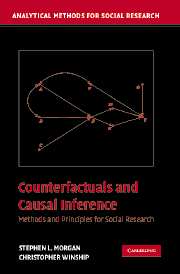Book contents
- Frontmatter
- Contents
- Acknowledgments
- Part 1 Counterfactual Causality and Empirical Research in the Social Sciences
- Part 2 Estimating Causal Effects by Conditioning
- Part 3 Estimating Causal Effects When Simple Conditioning Is Ineffective
- 6 Identification in the Absence of a Complete Model of Causal Exposure
- 7 Instrumental Variable Estimators of Causal Effects
- 8 Mechanisms and Causal Explanation
- 9 Repeated Observations and the Estimation of Causal Effects
- Part 4 Conclusions
- References
- Index
9 - Repeated Observations and the Estimation of Causal Effects
Published online by Cambridge University Press: 05 June 2012
- Frontmatter
- Contents
- Acknowledgments
- Part 1 Counterfactual Causality and Empirical Research in the Social Sciences
- Part 2 Estimating Causal Effects by Conditioning
- Part 3 Estimating Causal Effects When Simple Conditioning Is Ineffective
- 6 Identification in the Absence of a Complete Model of Causal Exposure
- 7 Instrumental Variable Estimators of Causal Effects
- 8 Mechanisms and Causal Explanation
- 9 Repeated Observations and the Estimation of Causal Effects
- Part 4 Conclusions
- References
- Index
Summary
As discussed in previous chapters, the fundamental problem of causal inference is that an individual cannot be simultaneously observed in both the treatment and control states. In some situations, however, it is possible to observe the same individual or unit of observation in the treatment and control states at different points in time. If time has no effect, then the causal effect of a treatment can be estimated as the difference between an individual's outcome under the control at time 1 and under the treatment at time 2. The assumption that time (and thus age for individuals) has no effect is often heroic. If, however, individuals' outcomes evolve in a predictable way, then it may be possible to use the longitudinal structure of the data to predict the counterfactual outcomes of each individual.
In this chapter, we will assume that the time at which treatment occurs is fixed. We will again focus on the consequences of nonrandom selection of individuals into the treatment and control groups. We will not, however, consider scenarios in which the specific timing of treatment is endogenous. This situation is considerably more complex because a treatment indicator must be modeled for every time period, recognizing that selection of the treatment in any single time period is not only a function of individual characteristics but also of previous decisions and expectations of future decisions.
- Type
- Chapter
- Information
- Counterfactuals and Causal InferenceMethods and Principles for Social Research, pp. 243 - 274Publisher: Cambridge University PressPrint publication year: 2007

